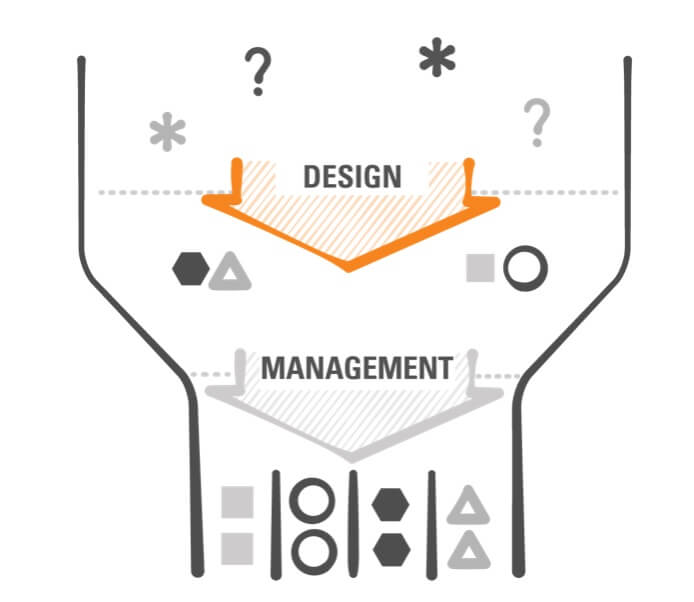How companies are optimizing their way to failure and the way design can save them
Published in: Selling Service Design Playbook
This model helps you to instantly explain where design fits in by showing how it compares to the current way of working that’s primarily focussed on management. It creates awareness around the gap that design fills.

When to use it
In our excitement about design we sometimes can create the sense that it’s a solution to every problem. But of course it’s not.
In the early stages of your sales journey it’s important that you share the type of challenges that fit a design approach and which ones don’t. By doing so you’ll identify the right clients and projects early on. And if there isn’t a good fit, don’t try to jam design into it.
This model visually explains that there are two types of business challenges:
- Figuring out what the right thing is you need to do.
- Doing that thing more efficiently.
Companies that are driven by management practices have become great at the second challenge. They invest most of their time and resources into optimising what’s already there.
Analytical thinking will never produce new insights because it’s always based on data from the past. So if you know your problem can be solved by something that already exists but just needs to be improved, analytical thinking is great. But if the solution doesn’t exist yet, analytical thinking will give you false hope. This is a really strong sales argument when talking with clients: do you think your problem can be solved with existing solutions?
— Roger Martin
Management is about scaling what already works. Standardising things. Doing things in a more reliable, faster and cheaper way.
But when you run into a challenge to which there isn’t a known solution yet, there isn’t anything to optimize. And in these scenarios management isn’t a very effective approach. This is where design comes in. Design is all about making sure that you’re doing the right thing and figuring out what that is. Design excels at navigating uncharted territory.
How does it work?
A good way into this model is by asking your potential client to name a few examples where the company had invested resources to optimize a solution just to realize at some point that they were fixing the wrong problem all along? As you’ll find, most companies will have plenty of examples.
By getting these examples first you’re articulating the gap where their current approach of solving challenges is falling short. For better or for worse you’re pointing out the weakness of management.
Once you have pointed out this weakness or gap it’s much easier to bring design into the conversation.
Because now you can establish if your potential client is really facing a challenge where there is a lot of uncertainty and the right path forward isn’t clear yet. If that’s the case then you can offer an effective approach to help them solve their challenge.
This model doesn’t compare design to all other approaches out there. Don’t fall into the trap of trying to explain everything with a single model. The goal here is to keep things simple and create a strong contrast to tell a story.
Why does it work
Every client understands the difference between challenges that are about doing better things and challenges focussed on doing things better. And many will have experienced the pain of optimizing a solution that doesn’t solve the real problem.
By acknowledging the difference between these two challenges it becomes clear for your client when you should use a design approach (and when you shouldn’t).
Example
A story that I like to reference is the one about McDonalds. McDonalds opened their first fast food burger restaurant in 1948. After that the business turned into a science scaling to an almost unimaginable size. But without their first insight that people wanted burgers without having to sit down and wait for a waitress to take their order, there wouldn’t have been anything to scale in the first place.
Of course there are countless stories of companies that have figured out what customers want and then ran with it with great success. But all these stories start with them having solved the challenge of creating something valuable that wasn’t there before. And the best way to do that is through design.
